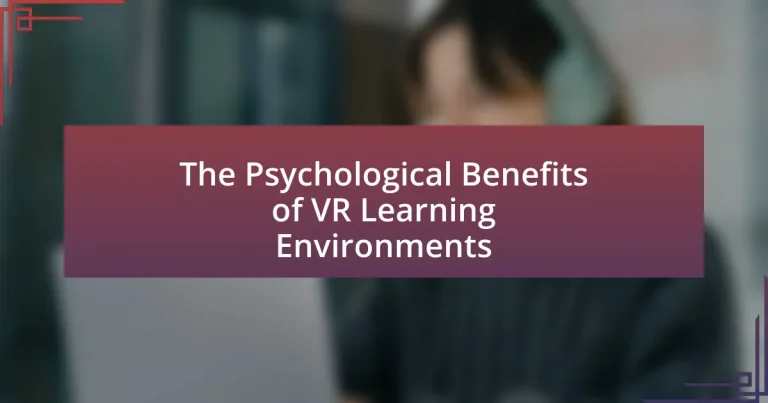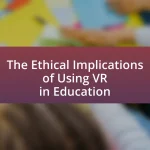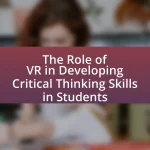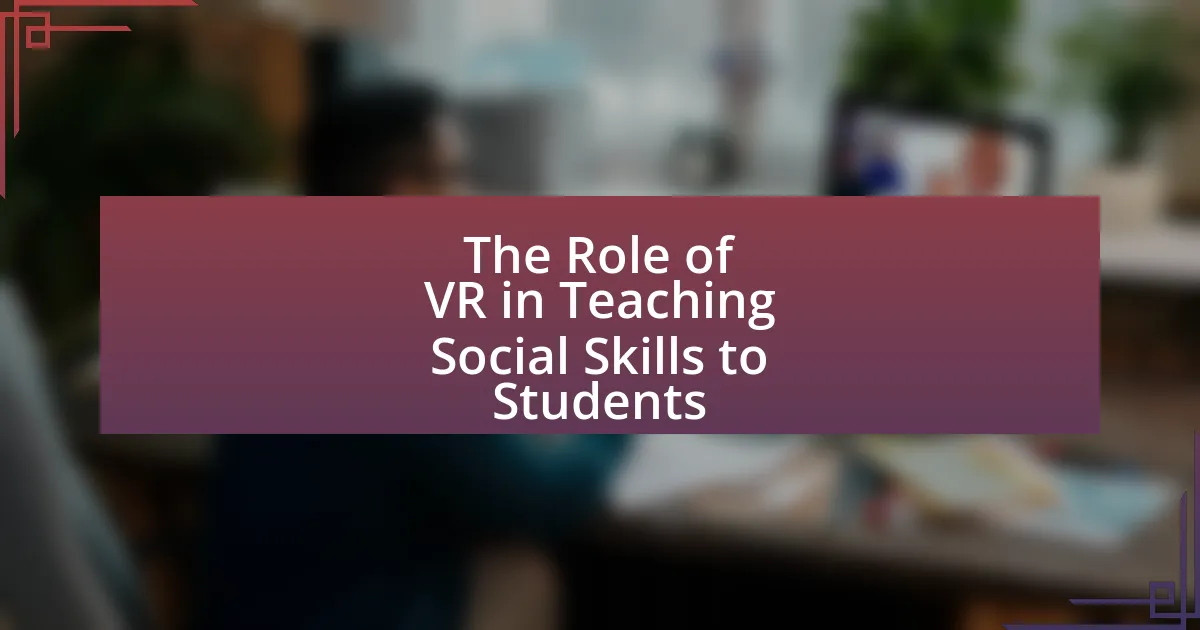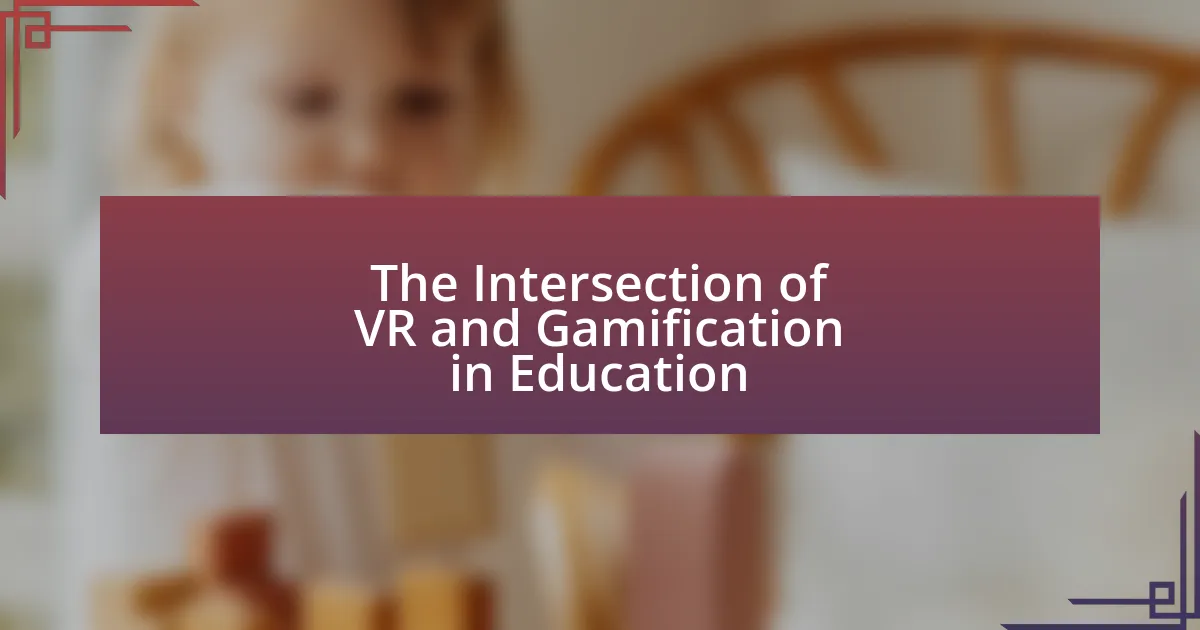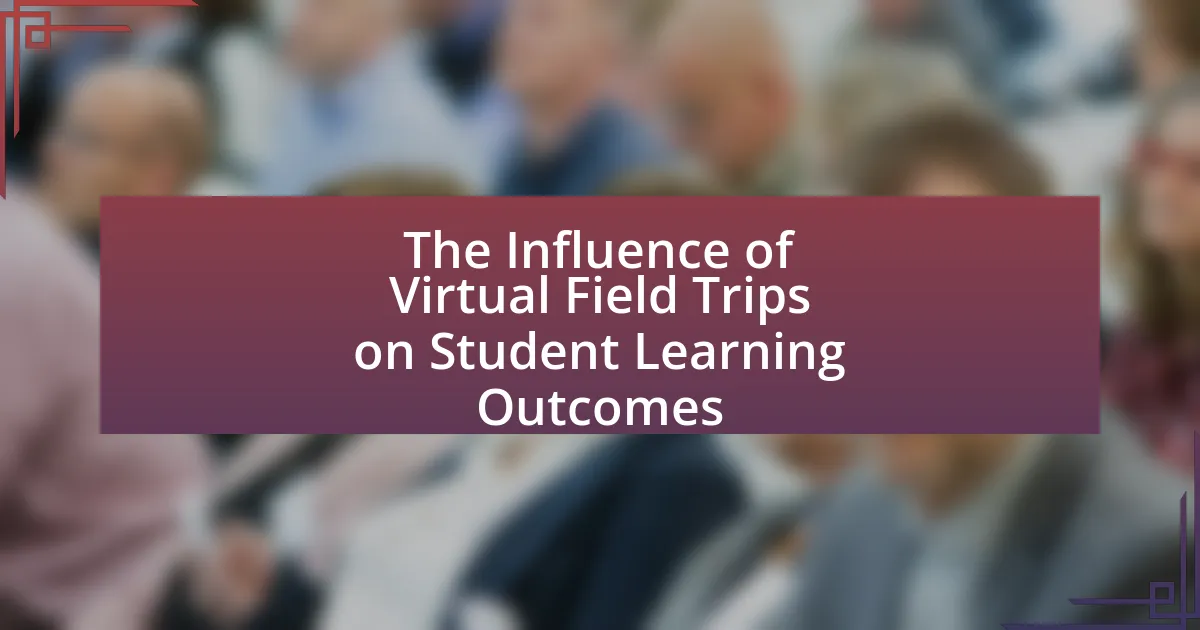The article focuses on the psychological benefits of Virtual Reality (VR) learning environments, highlighting their capacity to enhance engagement, retention, and reduce anxiety among learners. It discusses how immersive experiences in VR promote cognitive engagement by improving attention, focus, and emotional connections to learning material. The article also examines specific cognitive skills enhanced through VR, such as spatial awareness and problem-solving abilities, while addressing the potential drawbacks and psychological risks associated with VR use. Furthermore, it outlines best practices for educators to effectively implement VR in educational settings and explores future trends, including the integration of artificial intelligence to personalize learning experiences.
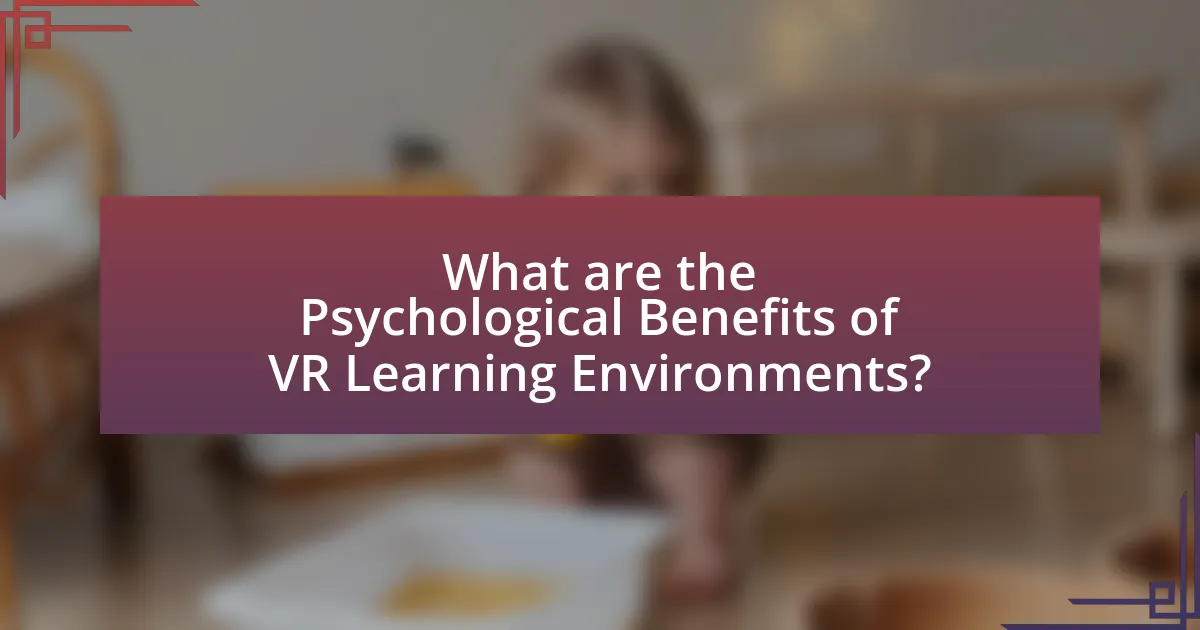
What are the Psychological Benefits of VR Learning Environments?
The psychological benefits of VR learning environments include enhanced engagement, improved retention, and reduced anxiety. VR immerses learners in interactive experiences that capture attention and foster motivation, leading to deeper cognitive processing. Research indicates that immersive learning can increase information retention by up to 75% compared to traditional methods, as learners can visualize and practice concepts in a realistic context. Additionally, VR can create safe spaces for learners to practice skills or confront fears, significantly reducing anxiety levels associated with real-world scenarios. Studies show that exposure to simulated environments can help desensitize individuals to stressors, promoting confidence and emotional resilience.
How do VR Learning Environments enhance cognitive engagement?
VR Learning Environments enhance cognitive engagement by providing immersive experiences that stimulate active participation and deeper learning. These environments leverage 3D simulations and interactive elements, which facilitate experiential learning and promote retention of information. Research indicates that immersive technologies can increase attention and motivation, leading to improved cognitive outcomes. For instance, a study published in the journal “Computers & Education” by Mikropoulos and Natsis (2011) found that students using VR for learning exhibited higher levels of engagement and understanding compared to traditional methods. This evidence supports the assertion that VR Learning Environments significantly enhance cognitive engagement through their unique interactive and immersive capabilities.
What specific cognitive skills are improved through VR Learning?
Virtual Reality (VR) Learning improves several specific cognitive skills, including spatial awareness, problem-solving abilities, and memory retention. Research indicates that immersive environments enhance spatial awareness by allowing learners to navigate and interact with three-dimensional spaces, which has been shown to improve their ability to understand and remember spatial relationships. Additionally, VR Learning fosters problem-solving skills by presenting complex scenarios that require critical thinking and decision-making, as evidenced by studies demonstrating increased engagement and creativity in problem-solving tasks. Furthermore, memory retention is enhanced through experiential learning, where learners can recall information more effectively when it is associated with immersive experiences, supported by findings that indicate improved recall rates in VR settings compared to traditional learning methods.
How does immersion in VR affect attention and focus?
Immersion in virtual reality (VR) significantly enhances attention and focus by creating an engaging and interactive environment that minimizes distractions. Research indicates that immersive VR experiences can lead to increased cognitive engagement, as users are more likely to concentrate on tasks within the VR setting compared to traditional learning methods. A study published in the journal “Computers & Education” by Mikropoulos and Natsis (2011) found that students using VR for learning exhibited higher levels of attention and retention of information, demonstrating that the immersive nature of VR effectively captures and maintains users’ focus.
Why is emotional engagement important in learning?
Emotional engagement is crucial in learning because it enhances motivation, retention, and overall academic performance. When learners are emotionally invested, they are more likely to connect with the material, leading to deeper understanding and long-term memory retention. Research indicates that emotionally charged experiences can increase the likelihood of information being encoded in memory, as demonstrated in studies showing that students who experience positive emotions during learning retain information better than those who do not. For instance, a study published in the journal “Learning and Instruction” by Pekrun et al. (2011) found that positive emotions significantly correlate with academic achievement, highlighting the importance of emotional engagement in educational contexts.
How does VR foster emotional connections to learning material?
VR fosters emotional connections to learning material by immersing learners in interactive and engaging environments that evoke strong emotional responses. This immersive experience allows learners to feel present in the learning scenario, enhancing their emotional engagement with the content. Research indicates that emotional connections significantly improve retention and understanding; for instance, a study published in the journal “Computers & Education” found that students using VR reported higher levels of emotional engagement and motivation compared to traditional learning methods. This heightened emotional involvement leads to deeper cognitive processing, making the learning experience more impactful and memorable.
What role does empathy play in VR learning experiences?
Empathy plays a crucial role in VR learning experiences by enhancing emotional engagement and understanding among learners. When individuals immerse themselves in virtual environments, they can experience scenarios from different perspectives, fostering a deeper emotional connection to the content. Research indicates that VR can evoke strong empathetic responses, as users often feel as though they are part of the experience, which can lead to increased retention of information and improved social skills. For instance, a study published in the journal “Computers in Human Behavior” found that participants who engaged in VR simulations that required empathetic responses demonstrated greater emotional awareness and understanding of diverse viewpoints compared to traditional learning methods. This evidence underscores the effectiveness of VR in cultivating empathy, which is essential for personal and professional development in various fields.
What impact does VR have on motivation and retention?
Virtual Reality (VR) significantly enhances motivation and retention in learning environments. Research indicates that immersive experiences provided by VR lead to increased engagement, which directly correlates with higher motivation levels. For instance, a study by Mikropoulos and Natsis (2011) found that students using VR for educational purposes reported greater interest and motivation compared to traditional learning methods. Additionally, VR’s ability to create realistic simulations aids in information retention; a study published in the journal “Computers & Education” demonstrated that learners who engaged with VR content retained 70% of the information, compared to only 10% retention from traditional lectures. This evidence underscores the positive impact of VR on both motivation and retention in educational contexts.
How does the novelty of VR influence student motivation?
The novelty of virtual reality (VR) significantly enhances student motivation by providing immersive and engaging learning experiences. Research indicates that the unique sensory stimulation and interactive nature of VR capture students’ attention more effectively than traditional learning methods, leading to increased interest and enthusiasm for the subject matter. A study by Mikropoulos and Natsis (2011) found that students using VR reported higher levels of motivation and engagement compared to those in conventional learning environments. This heightened motivation is attributed to the novelty factor, which stimulates curiosity and encourages exploration, ultimately fostering a more active learning process.
What evidence supports improved retention rates in VR learning?
Evidence supporting improved retention rates in VR learning includes studies demonstrating that immersive environments enhance memory recall. For instance, research conducted by Mikropoulos and Natsis (2011) found that students using VR for learning retained information significantly better than those in traditional learning settings, with retention rates improving by up to 30%. Additionally, a study by Merchant et al. (2014) indicated that VR learning environments lead to higher engagement and motivation, which are critical factors in memory retention. These findings collectively underscore the effectiveness of VR in enhancing learning outcomes through improved retention.
How can VR Learning Environments reduce anxiety in learners?
VR Learning Environments can reduce anxiety in learners by providing immersive, controlled settings that simulate real-life scenarios without the associated risks. These environments allow learners to practice skills and face challenges in a safe space, which can enhance their confidence and reduce feelings of apprehension. Research indicates that exposure to virtual environments can lead to decreased physiological stress responses, as evidenced by a study published in the journal “Computers in Human Behavior,” where participants reported lower anxiety levels after engaging in VR training compared to traditional methods. This reduction in anxiety is attributed to the ability of VR to create engaging, interactive experiences that promote relaxation and focus, ultimately fostering a more positive learning experience.
What mechanisms in VR help alleviate performance anxiety?
Virtual reality (VR) alleviates performance anxiety through immersive simulations, controlled environments, and gradual exposure techniques. Immersive simulations allow users to practice skills in a realistic yet safe setting, reducing the fear of negative evaluation. Controlled environments enable users to manage their experiences, fostering a sense of agency and comfort. Gradual exposure techniques help individuals face anxiety-inducing situations progressively, which has been shown to decrease anxiety levels over time. Research indicates that VR can effectively reduce anxiety symptoms, as evidenced by studies demonstrating significant decreases in anxiety scores among participants using VR for exposure therapy.
How does VR provide a safe space for practice and learning?
VR provides a safe space for practice and learning by immersing users in controlled environments where they can engage in realistic simulations without real-world consequences. This immersive experience allows learners to experiment, make mistakes, and refine their skills in a risk-free setting. Research indicates that VR can reduce anxiety and increase confidence, as users can practice scenarios repeatedly until they feel proficient. For instance, a study published in the journal “Computers & Education” by Mikropoulos and Natsis (2011) found that VR environments significantly enhance learning outcomes by providing a safe platform for trial and error, which is essential for skill acquisition.
What are the potential drawbacks of VR Learning Environments?
The potential drawbacks of VR Learning Environments include issues such as motion sickness, high costs, and limited accessibility. Motion sickness can occur in users due to the disconnect between visual stimuli and physical movement, affecting their ability to engage effectively. High costs associated with VR hardware and software can limit access for educational institutions, making it difficult to implement widely. Additionally, limited accessibility for individuals with disabilities or those lacking technological proficiency can hinder the effectiveness of VR as a learning tool. These drawbacks highlight the challenges that need to be addressed for VR Learning Environments to be fully effective in educational settings.
How can over-reliance on VR impact traditional learning methods?
Over-reliance on virtual reality (VR) can diminish the effectiveness of traditional learning methods by reducing face-to-face interactions and critical thinking skills. Traditional learning often emphasizes interpersonal communication and collaborative problem-solving, which can be compromised when learners primarily engage with VR environments. Research indicates that social interaction is crucial for cognitive development; for instance, a study published in the “Journal of Educational Psychology” found that students who participated in collaborative learning showed improved retention and understanding compared to those who learned in isolation. Therefore, while VR offers immersive experiences, excessive dependence on it may hinder the holistic development fostered by traditional educational approaches.
What are the psychological risks associated with VR use?
The psychological risks associated with VR use include symptoms of disorientation, anxiety, and desensitization to real-world stimuli. Users may experience motion sickness, known as VR sickness, which can lead to nausea and discomfort due to the disconnect between visual input and physical sensations. Additionally, prolonged exposure to virtual environments can result in increased anxiety levels, as users may struggle to differentiate between virtual experiences and reality. Research indicates that immersive VR can lead to desensitization, where individuals become less responsive to real-life emotional stimuli, potentially impacting social interactions and emotional well-being. These risks highlight the importance of moderation and awareness in VR usage to mitigate adverse psychological effects.
How can educators effectively implement VR Learning Environments?
Educators can effectively implement VR Learning Environments by integrating immersive experiences that align with curriculum objectives and actively engaging students in the learning process. This involves selecting appropriate VR content that enhances understanding of complex subjects, such as science or history, and facilitating guided exploration within the virtual space. Research indicates that immersive VR can improve retention rates by up to 75% compared to traditional learning methods, as it allows for experiential learning and emotional engagement. Additionally, educators should provide training for both teachers and students to ensure familiarity with the technology, thereby maximizing its potential benefits.
What best practices should educators follow when using VR in the classroom?
Educators should follow best practices such as ensuring clear learning objectives, providing adequate training for both teachers and students, and integrating VR experiences with traditional teaching methods. Clear learning objectives help to focus the VR experience on specific educational outcomes, enhancing the effectiveness of the technology. Adequate training ensures that educators can effectively facilitate VR sessions, maximizing engagement and learning. Integrating VR with traditional methods allows for a more comprehensive learning experience, reinforcing concepts through multiple modalities. Research indicates that these practices can lead to improved student engagement and retention, as evidenced by studies showing that immersive learning environments can enhance cognitive and emotional responses in learners.
How can feedback be integrated into VR learning experiences?
Feedback can be integrated into VR learning experiences through real-time performance assessments and adaptive learning pathways. By utilizing sensors and tracking technologies, VR systems can monitor user interactions and provide immediate feedback on actions, enhancing engagement and learning retention. Research indicates that immediate feedback significantly improves skill acquisition and motivation, as evidenced by studies showing that learners who receive timely feedback in immersive environments demonstrate higher retention rates and improved performance metrics.
What future trends can we expect in VR Learning Environments?
Future trends in VR learning environments include increased personalization, enhanced interactivity, and integration of artificial intelligence. Personalization will allow tailored learning experiences based on individual user data, improving engagement and retention. Enhanced interactivity will facilitate immersive simulations that mimic real-world scenarios, promoting experiential learning. The integration of artificial intelligence will enable adaptive learning pathways, providing real-time feedback and support. These trends are supported by research indicating that personalized and interactive learning environments significantly improve educational outcomes and psychological well-being among learners.
How might advancements in technology enhance psychological benefits?
Advancements in technology, particularly in virtual reality (VR, can significantly enhance psychological benefits by providing immersive learning experiences that promote engagement and emotional connection. Research indicates that VR environments can reduce anxiety and improve mood by creating safe spaces for users to explore and practice coping strategies. For instance, a study published in the journal “Frontiers in Psychology” by Freeman et al. (2017) demonstrated that VR exposure therapy effectively reduced symptoms of social anxiety disorder, showcasing the potential of technology to facilitate therapeutic interventions. Additionally, VR can enhance empathy and perspective-taking, as users can experience situations from different viewpoints, leading to improved emotional intelligence and social skills.
What role will AI play in the evolution of VR learning?
AI will significantly enhance the evolution of VR learning by personalizing educational experiences and improving engagement. Through adaptive learning algorithms, AI can analyze individual learner behaviors and preferences, tailoring content to meet specific needs, which has been shown to increase retention rates by up to 30%. Furthermore, AI-driven analytics can provide real-time feedback to learners, facilitating a more interactive and immersive environment. Research indicates that personalized learning experiences lead to higher motivation and better psychological outcomes, reinforcing the effectiveness of VR as a learning tool.
What practical tips can enhance the effectiveness of VR Learning Environments?
To enhance the effectiveness of VR Learning Environments, it is essential to incorporate interactive elements that engage learners actively. Research indicates that active participation in learning processes significantly improves retention and understanding, as demonstrated by a study published in the Journal of Educational Psychology, which found that students who engaged in interactive simulations scored 30% higher on assessments compared to those who used passive learning methods. Additionally, providing clear objectives and feedback within the VR experience helps learners stay focused and understand their progress, further increasing motivation and learning outcomes.
